The Hydro-Economic Interdependency of Cities: Virtual Water Connections of the Phoenix, Arizona Metropolitan Area
Abstract
:1. Introduction
2. Calculating Virtual Water Flows for the Phoenix Metropolitan Area
2.1. Study Area
2.2. Virtual Water Flow Calculation for Commodities at Municipal, County, and National Scales
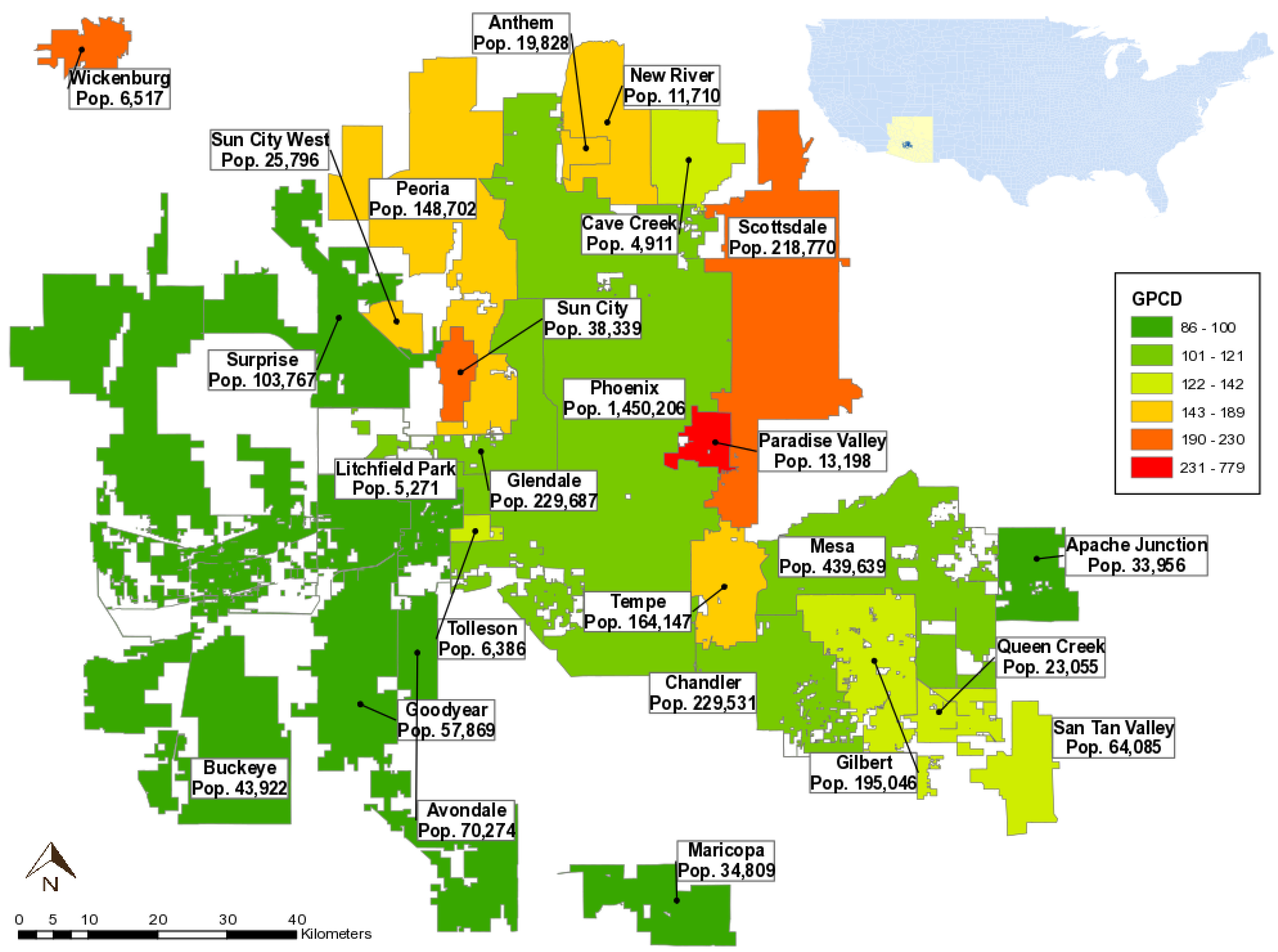
2.3. Virtual Water Flow Calculation for Labor at Intra-Metropolitan Scales
2.4. Disaggregation by Scale and Boundary of a Municipality’s Water Footprint
3. Results and Discussion
3.1. Virtual Water Inflows from the Nation and the Metropolitan Area
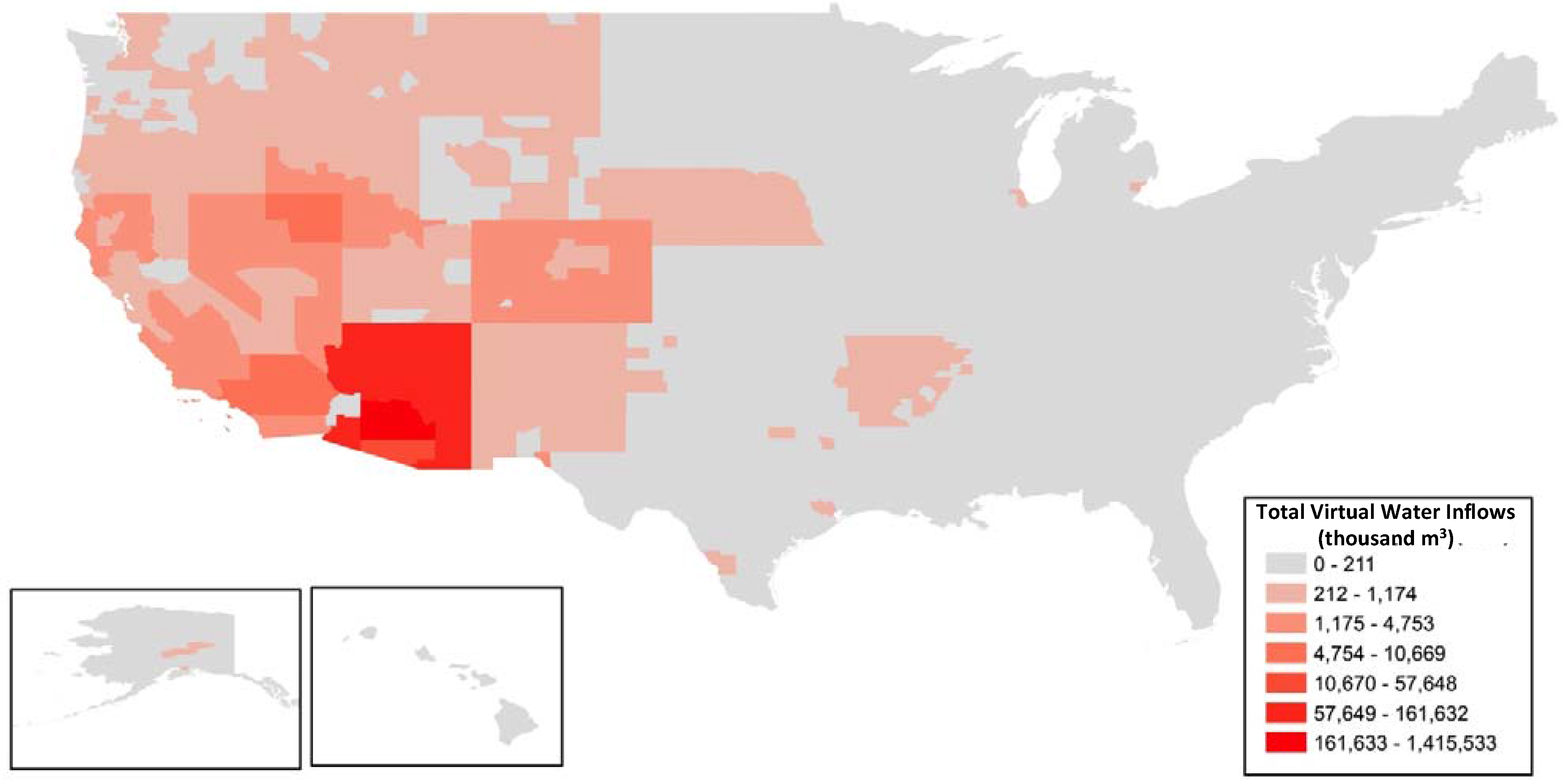
3.2. Virtual Water Outflows to the Nation and the Metropolitan Area
| Virtual Water Outflow Destination | Virtual Water Outflows (VC,Out) (Thousand m3) | % Total Virtual Water Export |
|---|---|---|
| Tucson AZ MSA | 132,579 | 5% |
| Remainder of Arizona | 309,351 | 12% |
| Phoenix AZ MSA * | 1,237,404 | 48% |
| Total Virtual Water Export to AZ | 1,679,334 | 65% |
| Total Virtual Water Export | 2,583,530 | 100% |
| * Includes Maricopa and Pinal County | ||
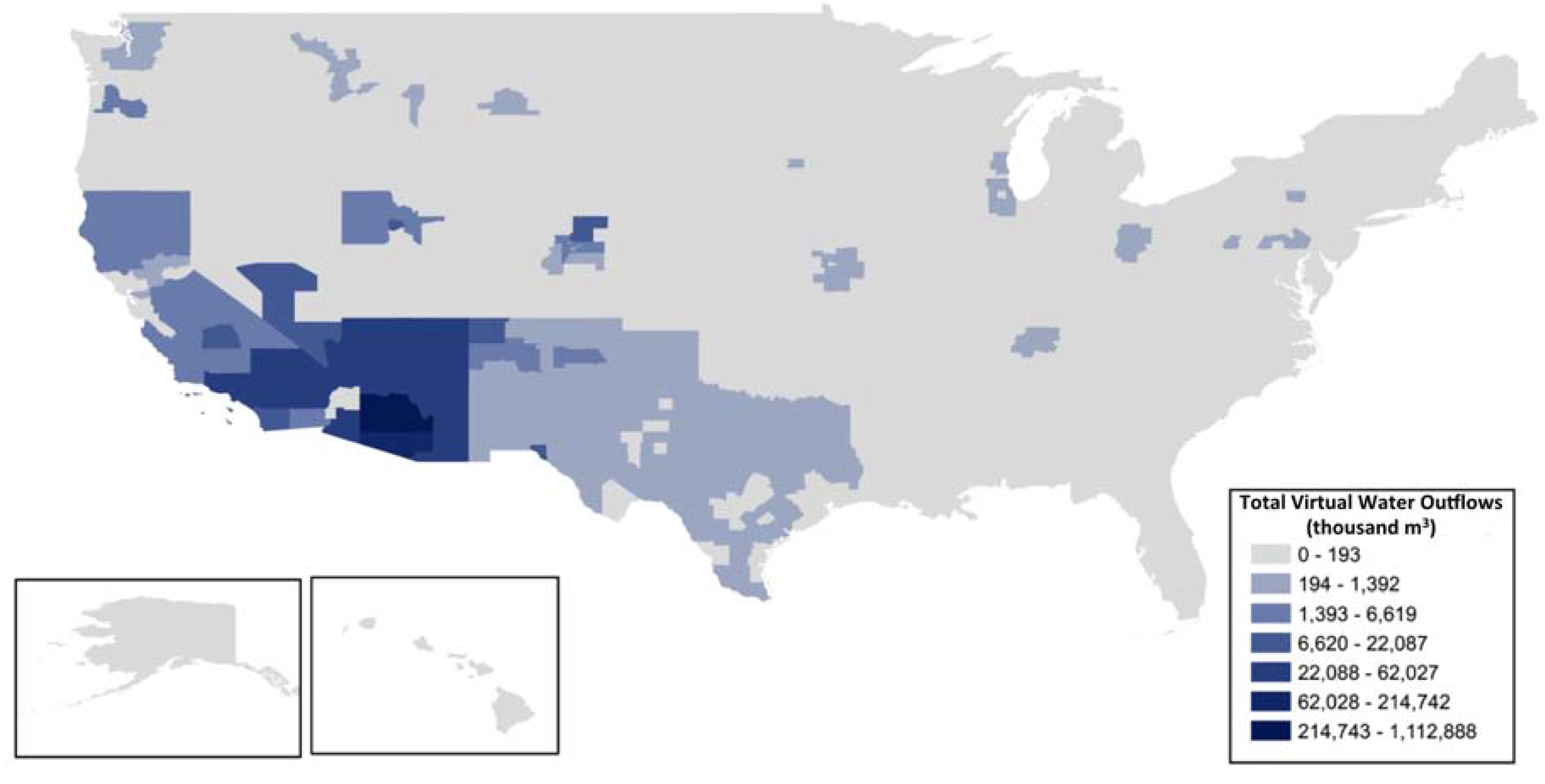
3.3. The Net Water Footprint of Commodities Consumed in the Metropolitan Area
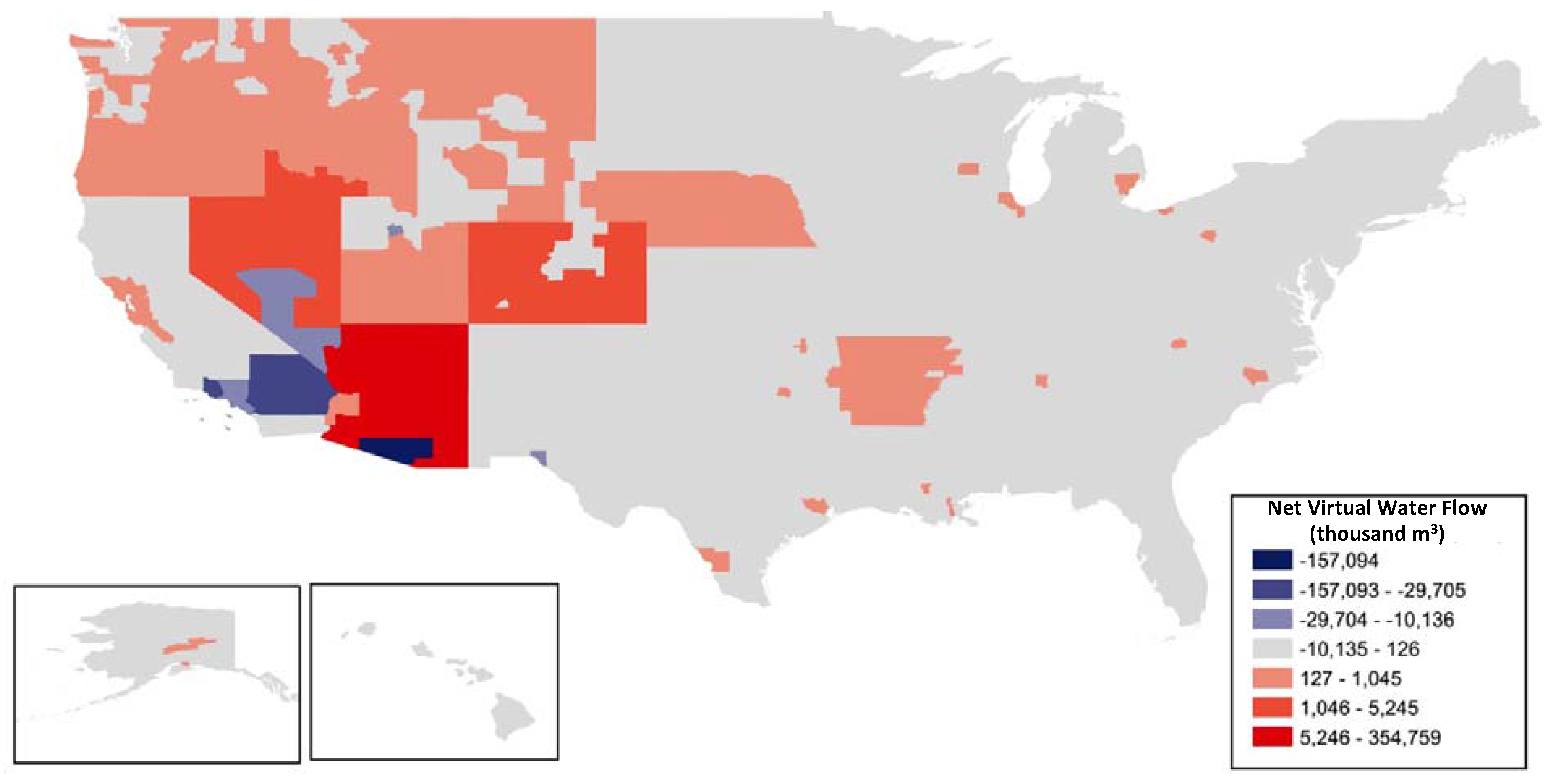
3.4. Virtual Water Flows Associated with Labor
3.5. Intra-Metropolitan Net Water Footprints
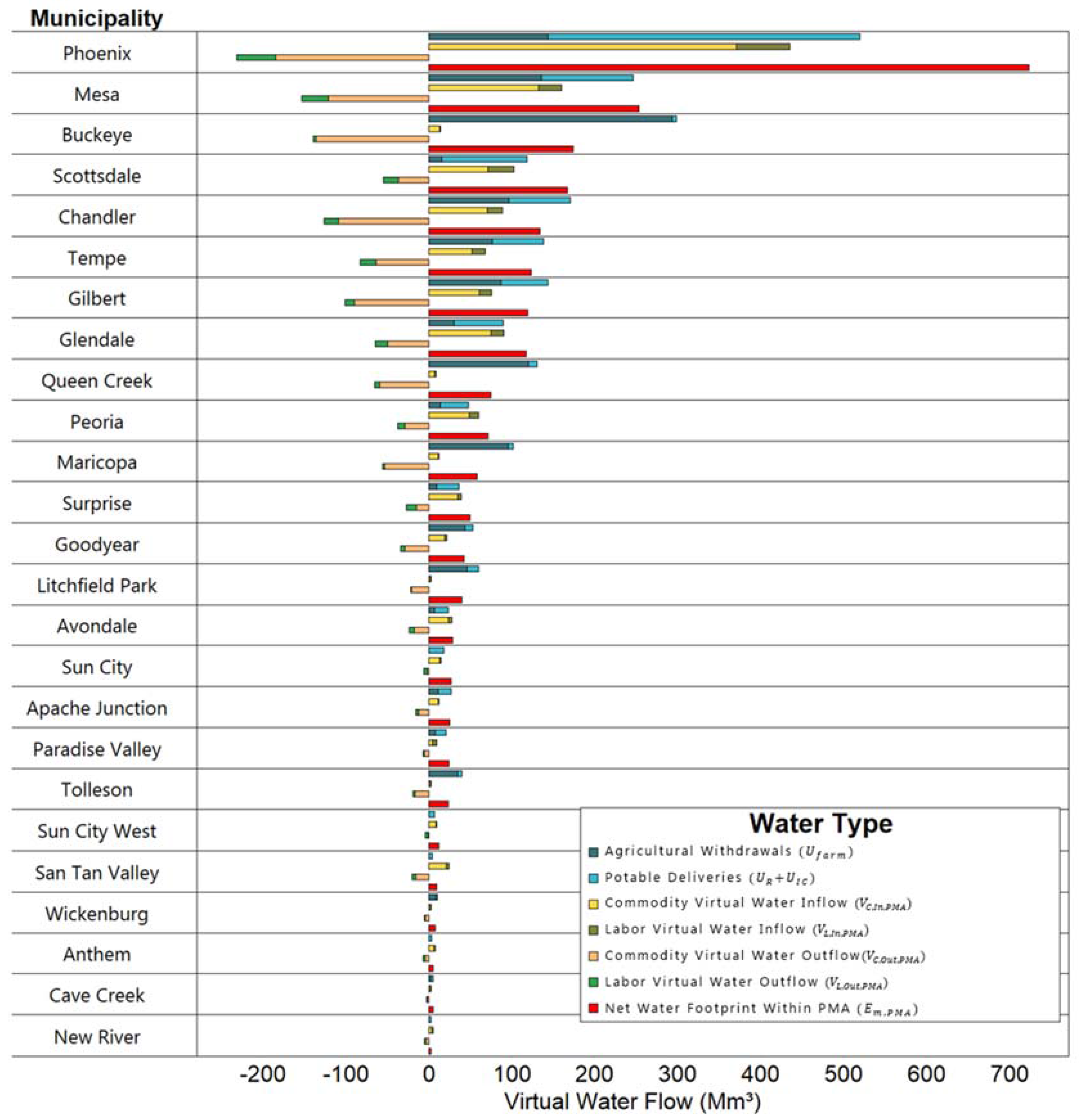
3.6. A Hydro-Economic Typology for Communities
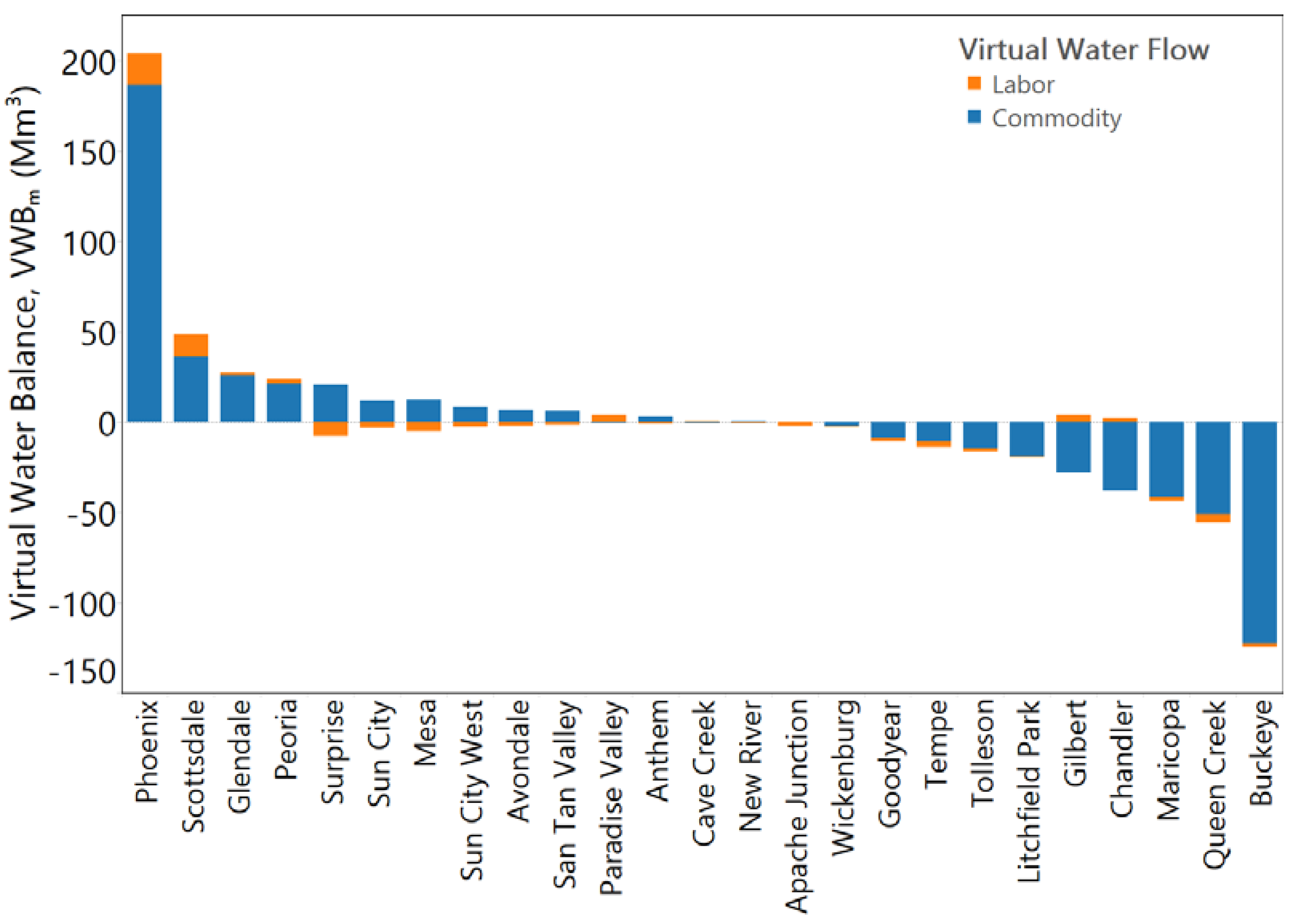

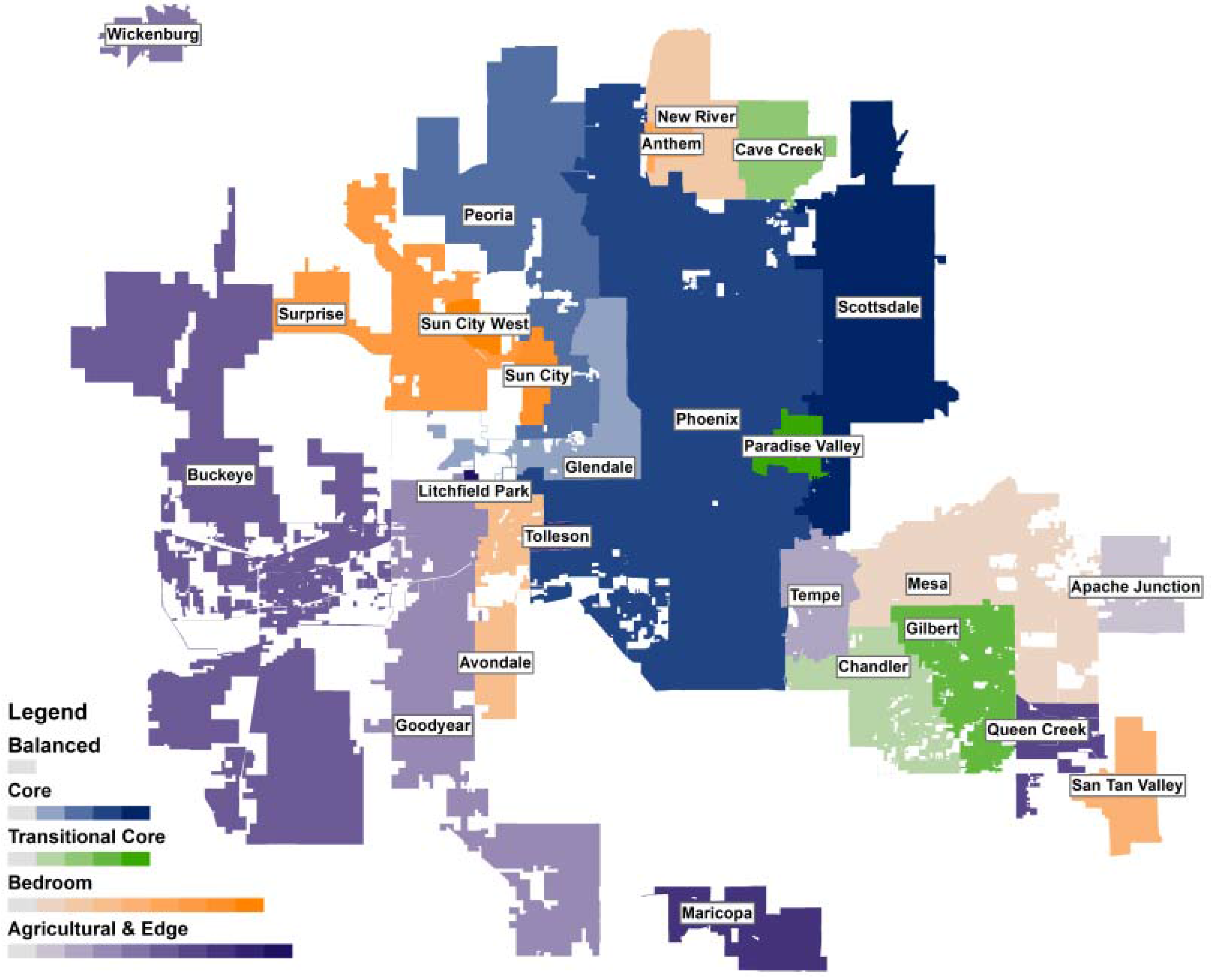
4. Conclusions
4.1. Summary
4.2. Broader Implications
Supplementary Files
Supplementary File 1Acknowledgments
Author Contributions
Conflicts of Interest
References
- Grimm, N.B.; Faeth, S.H.; Golubiewski, N.E.; Redman, C.L.; Wu, J.; Bai, X.; Briggs, J.M. Global Change and the Ecology of Cities. Science 2008, 319, 756–760. [Google Scholar] [CrossRef] [PubMed]
- Glaeser, E.L.; Kolko, J.; Saiz, A. Consumer City. J. Econ. Geogr. 2001, 1, 27–50. [Google Scholar] [CrossRef]
- Beaverstock, J.V.; Smith, R.G.; Taylor, P.J. World-City Network: A New Metageography? Annals Assoc. Am. Geogr. 2000, 90, 123–134. [Google Scholar] [CrossRef]
- Sassen, S. Cities in a World Economy; Sage Publications: Thousand Oaks, CA, USA, 2011. [Google Scholar]
- Sassen, S. The Global City: New York, London, Tokyo; Princeton University Press: Princeton, NJ, USA, 1991. [Google Scholar]
- Lo, C.; Yang, X. Drivers of Land-Use/Land-Cover Changes and Dynamic Modeling for the Atlanta, Georgia Metropolitan Area. Photogramm. Eng. Remote Sens. 2002, 68, 1073–1082. [Google Scholar]
- Mills, E.S. An Aggregative Model of Resource Allocation in a Metropolitan Area. Am. Econ. Rev. 1967, 57, 197–210. [Google Scholar]
- Batty, M. Polynucleated Urban Landscapes. Urban Stud. 2001, 38, 635–655. [Google Scholar] [CrossRef]
- Rinaldi, S.M.; Peerenboom, J.P.; Kelly, T.K. Identifying, Understanding, and Analyzing Critical Infrastructure Interdependencies. Control Syst. IEEE 2001, 21, 11–25. [Google Scholar] [CrossRef]
- Pederson, P.; Dudenhoeffer, D.; Hartley, S.; Permann, M. Critical Infrastructure Interdependency Modeling: A Survey of US and International Research. Available online: www5vip.inl.gov/technicalpublications/Documents/3489532.pdf (accessed on 26 June 2015).
- Roberts, M.J. River Basin Authorities: A National Solution to Water Pollution. Harv. Law Rev. 1970, 83, 1527–1556. [Google Scholar] [CrossRef]
- Davis, M.D. Integrated Water Resource Management and Water Sharing. J. Water Resour. Plan. Manag. 2007, 133, 427–445. [Google Scholar] [CrossRef]
- Giordano, M.A.; Wolf, A.T. Natural Resources Forum. In Sharing Waters: Post-Rio International Water Management; John Wiley & Sons: Hoboken, NJ, USA, 2003; pp. 163–171. [Google Scholar]
- Herman, J.D.; Zeff, H.B.; Reed, P.M.; Characklis, G.W. Beyond Optimality: Multistakeholder Robustness Tradeoffs for Regional Water Portfolio Planning under Deep Uncertainty. Water Resour. Res. 2014, 50, 7692–7713. [Google Scholar] [CrossRef]
- Kasprzyk, J.R.; Reed, P.M.; Kirsch, B.R.; Characklis, G.W. Managing Population and Drought Risks Using Many-Objective Water Portfolio Planning under Uncertainty. Water Resour. Res. 2009, 45, W12401. [Google Scholar] [CrossRef]
- Ruddell, B.L.; Adams, E.A.; Rushforth, R.; Tidwell, V.C. Embedded Resource Accounting for Coupled Natural-Human Systems: An Application to Water Resource Impacts of the Western US Electrical Energy Trade. Water Resour. Res. 2014, 50, 7957–7972. [Google Scholar] [CrossRef]
- Rushforth, R.R.; Adams, E.A.; Ruddell, B.L. Generalizing Ecological, Water and Carbon Footprint Methods and Their Worldview Assumptions Using Embedded Resource Accounting. Water Resour. Ind. 2013, 1, 77–90. [Google Scholar] [CrossRef]
- Kennedy, C.A.; Stewart, I.; Facchini, A.; Cersosimo, I.; Mele, R.; Chen, B.; Uda, M.; Kansal, A.; Chiu, A.; Kim, K.-G.; et al. Energy and Material Flows of Megacities. Proc. Natl. Acad. Sci. USA 2015, 112, 5985–5990. [Google Scholar] [CrossRef] [PubMed]
- Baum-Snow, N. Changes in Transportation Infrastructure and Commuting Patterns in US Metropolitan Areas, 1960–2000. Am. Econ. Rev. 2010, 100, 378–382. [Google Scholar] [CrossRef] [PubMed]
- Opie, K.; Rowinski, J.; Spasovic, L.N. Commodity-Specific Disaggregation of 2002 Freight Analysis Framework Data to County Level in New Jersey. Transp. Res. Record 2009, 2121, 128–134. [Google Scholar] [CrossRef]
- Hoff, H.; Döll, P.; Fader, M.; Gerten, D.; Hauser, S.; Siebert, S. Water Footprints of Cities—Indicators for Sustainable Consumption and Production. Hydrol. Earth Syst. Sci. 2014, 18, 213–226. [Google Scholar] [CrossRef]
- Jenerette, G.D.; Wu, W.; Goldsmith, S.; Marussich, W.A.; Roach, W.J. Contrasting Water Footprints of Cities in China and the United States. Ecol. Econ. 2006, 57, 346–358. [Google Scholar] [CrossRef]
- Vanham, D.; Bidoglio, G. The Water Footprint of Milan. Water Sci. Technol. 2014, 69, 789–795. [Google Scholar] [CrossRef] [PubMed]
- Dalin, C.; Konar, M.; Hanasaki, N.; Rinaldo, A.; Rodriguez-Iturbe, I. Evolution of the Global Virtual Water Trade Network. Proc. Natl. Acad. Sci. USA 2012, 109, 5989–5994. [Google Scholar] [CrossRef] [PubMed]
- Suweis, S.; Konar, M.; Dalin, C.; Hanasaki, N.; Rinaldo, A.; Rodriguez-Iturbe, I. Structure and Controls of the Global Virtual Water Trade Network. Geophys. Res. Lett. 2011. [Google Scholar] [CrossRef]
- Patterson, W.; Rushforth, R.; Ruddell, B.L.; Ikechukwu, C.; Gironás, J.; Konar, M.; Mijic, A.; Mejia, A. Water Footprint of Cities: A Review and Suggestions for Future Research. Sustainability 2015, in press. [Google Scholar]
- Liu, J.; Mooney, H.; Hull, V.; Davis, S.J.; Gaskell, J.; Hertel, T.; Lubchenco, J.; Seto, K.C.; Gleick, P.; Kremen, C. Systems Integration for Global Sustainability. Science 2015, 347. [Google Scholar] [CrossRef] [PubMed]
- Seto, K.C.; Reenberg, A.; Boone, C.G.; Fragkias, M.; Haase, D.; Langanke, T.; Marcotullio, P.; Munroe, D.K.; Olah, B.; Simon, D. Urban Land Teleconnections and Sustainability. Proc. Natl. Acad. Sci. USA 2012, 109, 7687–7692. [Google Scholar] [CrossRef] [PubMed]
- White, D.D.; Withycombe Keeler, L.; Wiek, A.; Larson, K.L. Envisioning the Future of Water Governance: A Survey of Central Arizona Water Decision Makers. Environ. Prac. 2015, 17, 25–35. [Google Scholar] [CrossRef]
- U.S. Census Bureau Population Division. Table 1. Annual Estimates of the Population of Metropolitan and Micropolitan Statistical Areas: 1 April 2010 to 1 July 2011 (CBSA-EST2011-01). Avaiable online: https://www.census.gov/popest/data/metro/totals/2011/ (accessed on 2 December 2014).
- Zients, J. Omb Bulletin No. 13–01: Revised Delineations of Metropolitan Statistical Areas, Micropolitan Statistical Areas, and Combined Statistical Areas, and Guidance on Uses of the Delineations of These Areas; Office of Management and Budget: Washington, DC, USA, 2013. [Google Scholar]
- Sampson, D.A.; Escobar, V.; Tschudi, M.K.; Lant, T.; Gober, P. A Provider-Based Water Planning and Management Model—Watersim 4.0—for the Phoenix Metropolitan Area. J. Environ. Manag. 2011, 92, 2596–2610. [Google Scholar] [CrossRef] [PubMed]
- U.S. Census Buearu. 2010 Census of Population and Housing, Population and Housing Unit Counts, Cph-2–1, United States Summary. U.S.; Government Printing Office: Washington, DC, USA, 2012. [Google Scholar]
- Harlan, S.L.; Yabiku, S.T.; Larsen, L.; Brazel, A.J. Household Water Consumption in an Arid City: Affluence, Affordance, and Attitudes. Soc. Nat. Resour. 2009, 22, 691–709. [Google Scholar] [CrossRef]
- Ouyang, Y.; Wentz, E.A.; Ruddell, B.L.; Harlan, S.L. A Multi-Scale Analysis of Single-Family Residential Water Use in the Phoenix Metropolitan Area. JAWRA 2014, 50, 448–467. [Google Scholar] [CrossRef]
- Tian, G.; Ouyang, Y.; Quan, Q.; Wu, J. Simulating Spatiotemporal Dynamics of Urbanization with Multi-Agent Systems—A Case Study of the Phoenix Metropolitan Region, USA. Ecol. Model. 2011, 222, 1129–1138. [Google Scholar] [CrossRef]
- Southworth, F.; Davidson, D.; Hwang, H.; Peterson, B.E.; Chin, S. The Freight Analysis Framework, Version 3: Overview of the FAF3 National Freight Flow Tables. Available online: http://www.faf.ornl.gov/fafweb/Data/FAF3ODCMOverview.pdf (accessed on 2 December 2014).
- U.S. Census Buearu. 2007 Commodity Flow Survey Standard Classification of Transported Goods (Sctg), Sctg Commodity Codes, Cfs-1200. Available online: https://www.census.gov/svsd/www/cfsdat/cfs071200.pdf (accessed on 2 December 2014).
- Dang, Q.; Lin, X.; Konar, M. Agricultural Virtual Water Flows within the United States. Water Resour. Res. 2015, 51, 973–986. [Google Scholar] [CrossRef]
- Mahmoudifard, S.M.; Ko, S.; Mohammadian, K. Assessing Sustainable Freight Policies. Available online: https://www.census.gov/svsd/www/cfsdat/cfs071200.pdf (accessed on 26 June 2014).
- U.S. Census Buearu. American Community Survey, 2010, 2008–2012 American Community Survey 5-Year Estimates, Table DP-03; Generated by Richard Rushforth. Using American Factfinder. Avaiable online: http://factfinder2.census.gov (accessed on 2 December 2014).
- USDA NASS. 2007 Census of Agriculture, Quick Stats. Avaiable online: http://quickstats.nass.usda.gov/ (accessed on 2 December 2014).
- Kenny, J.F.; Barber, N.L.; Hutson, S.S.; Linsey, K.S.; Lovelace, J.K.; Maupin, M.A. Estimated Use of Water in the United States in 2005. Available online: http://www.pubs.usgs.gov/circ/1344/pdf/c1344.pdf (accessed on 3 September 2014).
- Viswanathan, K.; Beagan, D.; Mysore, V.; Srinivasan, N. Disaggregating Freight Analysis Framework Version 2 Data for Florida: Methodology and Results. Transp. Res. Record 2008, 2049, 167–175. [Google Scholar] [CrossRef]
- Bujanda, A.; Villa, J.; Williams, J. Development of Statewide Freight Flows Assignment Using the Freight Analysis Framework (FAF 3). J. Behav. Econ. Finan. Entrep. Account. Transp. 2014, 2, 47–57. [Google Scholar]
- Harris, G.A.; Anderson, M.D.; Farrington, P.A.; Schoening, N.C.; Swain, J.J.; Sharma, N.S. Developing Freight Analysis Zones at a State Level: A Cluster Analysis Approach. J. Transp. Res. Forum 2012, 49, 59–68. [Google Scholar] [CrossRef]
- De Jong, G.; Gunn, H.; Walker, W. National and International Freight Transport Models: An Overview and Ideas for Future Development. Trans. Rev. 2004, 24, 103–124. [Google Scholar]
- U.S. Census Bureau. Workforce Indicators Data. Longitudinal-Employer Household Dynamics Program. x . Avaiable online: http://qwiexplorer.ces.census.gov (accessed on 2 December 2014).
- U.S. Census Bureau, 2006–2010 American Community Survey 5-Year Estimates. Avaiable online: https://www.census.gov/hhes/commuting/data/acs2006_2010.html (accessed on 2 December 2014).
- Thorsen, I.; Gitlesen, J.P. Empirical Evaluation of Alternative Model Specifications to Predict Commuting Flows. J. Reg. Sci. 1998, 38, 273–292. [Google Scholar] [CrossRef]
- Maricopa County Air Quality Department. Trip Reduction Program Annual Report 2010; Maricopa County Air Quality Department: Phoenix, AZ, USA, 2011. [Google Scholar]
- Arizona Department of Water Resources. Notification of 2009 Gallons Per Capita Per Day (Gpcd) and Lost and Unaccounted (L&U) for Water Percentages. (Report Nunber: 56-002025.0000); Arizona Department of Water Resources: Phoenix, AZ, USA, 2011. [Google Scholar]
- Arizona Department of Water Resources. Notification of 2009 Gallons Per Capita Per Day (Gpcd) and Lost and Unaccounted (L&U) for Water Percentages. (Report Number: 56-002019.0000); Arizona Department of Water Resources: Phoenix, AZ, USA, 2011. [Google Scholar]
- Arizona Department of Water Resources. Notification of 2009 Gallons Per Capita Per Day (Gpcd) and Lost and Unaccounted (L&U) for Water Percentages. (Report Number: 56-002021.0000); Arizona Department of Water Resources: Phoenix, AZ, USA, 2011. [Google Scholar]
- Arizona Department of Water Resources. Notification of 2009 Gallons Per Capita Per Day (Gpcd) and Lost and Unaccounted (L&U) for Water Percentages. (Report Number: 56-002006.0000); Arizona Department of Water Resources: Phoenix, AZ, USA, 2011. [Google Scholar]
- Arizona Department of Water Resources. Notification of 2009 Gallons Per Capita Per Day (Gpcd) and Lost and Unaccounted (L&U) for Water Percentages. (Report Number: 56-002008.0000); Arizona Department of Water Resources: Phoenix, AZ, USA, 2011. [Google Scholar]
- Arizona Department of Water Resources. Notification of 2009 Gallons Per Capita Per Day (Gpcd) and Lost and Unaccounted (L&U) for Water Percentages. (Report Number: 56-002009.0000); Arizona Department of Water Resources: Phoenix, AZ, USA, 2011. [Google Scholar]
- Arizona Department of Water Resources. Notification of 2009 Gallons Per Capita Per Day (Gpcd) and Lost and Unaccounted (L&U) for Water Percentages. (Report Number: 56–002017.0000); Arizona Department of Water Resources: Phoenix, AZ, USA, 2011. [Google Scholar]
- Arizona Department of Water Resources. Notification of 2009 Gallons Per Capita Per Day (Gpcd) and Lost and Unaccounted (L&U) for Water Percentages. (Report Number: 56–002018.0000); Arizona Department of Water Resources: Phoenix, AZ, USA, 2011. [Google Scholar]
- Arizona Department of Water Resources. Notification of 2009 Gallons Per Capita Per Day (Gpcd) and Lost and Unaccounted (L&U) for Water Percentages. (Report Number: 56–001355.0000); Arizona Department of Water Resources: Phoenix, AZ, USA, 2011. [Google Scholar]
- Arizona Department of Water Resources. Notification of 2009 Gallons Per Capita Per Day (Gpcd) and Lost and Unaccounted (L&U) for Water Percentages. (Report Number: 56–002023.0000); Arizona Department of Water Resources: Phoenix, AZ, USA, 2011. [Google Scholar]
- Arizona Department of Water Resources. Notification of 2009 Gallons Per Capita Per Day (Gpcd) and Lost and Unaccounted (L&U) for Water Percentages. (Report Number: 56–0022254.0000); Arizona Department of Water Resources: Phoenix, AZ, USA, 2011. [Google Scholar]
- Arizona Department of Water Resources. Notification of 2009 Gallons Per Capita Per Day (Gpcd) and Lost and Unaccounted (L&U) for Water Percentages. (Report Number: 56–002027.0000); Arizona Department of Water Resources: Phoenix, AZ, USA, 2011. [Google Scholar]
- Arizona Department of Water Resources. Notification of 2009 Gallons Per Capita Per Day (Gpcd) and Lost and Unaccounted (L&U) for Water Percentages. (Report Number: 56–002029.0000); Arizona Department of Water Resources: Phoenix, AZ, USA, 2011. [Google Scholar]
- Arizona Department of Water Resources. Notification of 2009 Gallons Per Capita Per Day (Gpcd) and Lost and Unaccounted (L&U) for Water Percentages. (Report Number: 56–002030.0000); Arizona Department of Water Resources: Phoenix, AZ, USA, 2011. [Google Scholar]
- Arizona Department of Water Resources. Notification of 2009 Gallons Per Capita Per Day (Gpcd) and Lost and Unaccounted (L&U) for Water Percentages. (Report Number: 56–002032.0000); Arizona Department of Water Resources: Phoenix, AZ, USA, 2011. [Google Scholar]
- Arizona Department of Water Resources. Notification of 2009 Gallons Per Capita Per Day (Gpcd) and Lost and Unaccounted (L&U) for Water Percentages. (Report Number: 56–002020.0000); Arizona Department of Water Resources: Phoenix, AZ, USA, 2011. [Google Scholar]
- Arizona Department of Water Resources. Notification of 2009 Gallons Per Capita Per Day (Gpcd) and Lost and Unaccounted (L&U) for Water Percentages. (Report Number: 56–002037.0000); Arizona Department of Water Resources: Phoenix, AZ, USA, 2011. [Google Scholar]
- Arizona Department of Water Resources. Notification of 2009 Gallons Per Capita Per Day (Gpcd) and Lost and Unaccounted (L&U) for Water Percentages. (Report Number: 56–002038.0000); Arizona Department of Water Resources: Phoenix, AZ, USA, 2011. [Google Scholar]
- Arizona Department of Water Resources. Notification of 2009 Gallons Per Capita Per Day (Gpcd) and Lost and Unaccounted (L&U) for Water Percentages. (Report Number: 56–002039.0000); Arizona Department of Water Resources: Phoenix, AZ, USA, 2011. [Google Scholar]
- Arizona Department of Water Resources. Notification of 2009 Gallons Per Capita Per Day (Gpcd) and Lost and Unaccounted (L&U) for Water Percentages. (Report Number: 56–002344.0000); Arizona Department of Water Resources: Phoenix, AZ, USA, 2011. [Google Scholar]
- Arizona Department of Water Resources. Notification of 2009 Gallons Per Capita Per Day (Gpcd) and Lost and Unaccounted (L&U) for Water Percentages. (Report Number: 56–002043.0000); Arizona Department of Water Resources: Phoenix, AZ, USA, 2011. [Google Scholar]
- Arizona Department of Water Resources. Notification of 2009 Gallons Per Capita Per Day (Gpcd) and Lost and Unaccounted (L&U) for Water Percentages. (Report Number: 56–002044.0000); Arizona Department of Water Resources: Phoenix, AZ, USA, 2011. [Google Scholar]
- Town of Wickenburg. Town of Wickenburg, Arizona Comprehensive Annual Financial Report for the Year Ended 30 June 2012; Town of Wickenburg: Wickenburg, AZ, USA, 2012. Available online: http://gfoa.net/cafr/COA2012/WickenburgAZ.pdf (accessed on 2 December 2014).
- Aldaya, M.M.; Chapagain, A.K.; Hoekstra, A.Y.; Mekonnen, M.M. The Water Footprint Assessment Manual: Setting the Global Standard; Routledge: London, UK, 2012. [Google Scholar]
- Haas, W.; Krausmann, F.; Wiedenhofer, D.; Heinz, M. How Circular Is the Global Economy?: An Assessment of Material Flows, Waste Production, and Recycling in the European Union and the World in 2005. J. Ind. Ecol. 2015. [Google Scholar] [CrossRef]
- Mekonnen, M.M.; Hoekstra, A.Y. National Water Footprint Accounts: The Green, Blue and Grey Water Footprint of Production and Consumption, Volume 1: Main Report; UNESCO-IHE Institute for Water Eduation: Delft, The Netherlands, 2011. Available online: http://www.doc.utwente.nl/76913/1/Report50-NationalWaterFootprints-Vol1.pdf (accessed on 2 December 2014).
- Reimer, J.J. On the Economics of Virtual Water Trade. Ecol. Econ. 2012, 75, 135–139. [Google Scholar] [CrossRef]
- Kenessey, Z. The Primary, Secondary, Tertiary and Quaternary Sectors of the Economy. Rev. Income Wealth 1987, 33, 359–385. [Google Scholar] [CrossRef]
- Cook, B.I.; Ault, T.R.; Smerdon, J.E. Unprecedented 21st Century Drought Risk in the American Southwest and Central Plains. Sci. Adv. 2015, 1, e1400082. [Google Scholar] [CrossRef]
- Gober, P.; Kirkwood, C.W. Vulnerability Assessment of Climate-Induced Water Shortage in Phoenix. Proc. Natl. Acad. Sci. 2010, 107, 21295–21299. [Google Scholar] [CrossRef] [PubMed]
- Merrett, S. Virtual Water and the Kyoto Consensus. Water Int. 2003, 28, 540–542. [Google Scholar] [CrossRef]
- Samuelson, P.A. An Exact Hume-Ricardo-Marshall Model of International Trade. J. Int. Econ. 1971, 1, 1–18. [Google Scholar] [CrossRef]
© 2015 by the authors; licensee MDPI, Basel, Switzerland. This article is an open access article distributed under the terms and conditions of the Creative Commons Attribution license (http://creativecommons.org/licenses/by/4.0/).
Share and Cite
Rushforth, R.R.; Ruddell, B.L. The Hydro-Economic Interdependency of Cities: Virtual Water Connections of the Phoenix, Arizona Metropolitan Area. Sustainability 2015, 7, 8522-8547. https://doi.org/10.3390/su7078522
Rushforth RR, Ruddell BL. The Hydro-Economic Interdependency of Cities: Virtual Water Connections of the Phoenix, Arizona Metropolitan Area. Sustainability. 2015; 7(7):8522-8547. https://doi.org/10.3390/su7078522
Chicago/Turabian StyleRushforth, Richard R., and Benjamin L. Ruddell. 2015. "The Hydro-Economic Interdependency of Cities: Virtual Water Connections of the Phoenix, Arizona Metropolitan Area" Sustainability 7, no. 7: 8522-8547. https://doi.org/10.3390/su7078522
APA StyleRushforth, R. R., & Ruddell, B. L. (2015). The Hydro-Economic Interdependency of Cities: Virtual Water Connections of the Phoenix, Arizona Metropolitan Area. Sustainability, 7(7), 8522-8547. https://doi.org/10.3390/su7078522





